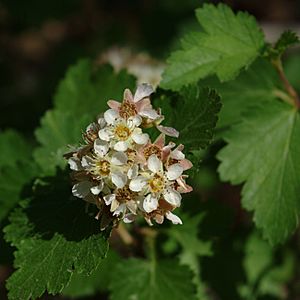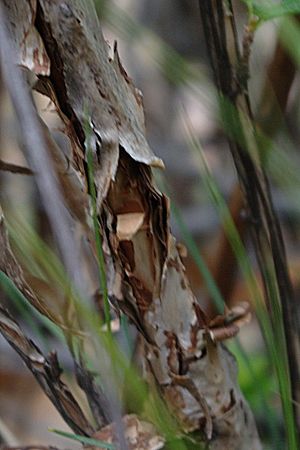Mountain ninebark facts for kids
Quick facts for kids Mountain ninebark |
|
|---|---|
 |
|
| Scientific classification | |
| Genus: |
Physocarpus
|
| Species: |
monogynus
|
Physocarpus monogynus, also known as the mountain ninebark or low ninebark, is a cool flowering shrub that grows in western North America. It's known for its interesting peeling bark and pretty flowers.
Where the Mountain Ninebark Lives
The mountain ninebark plant grows in many places across western North America. You can find it from northern Mexico and western Texas, all the way north to Montana and South Dakota. It also grows west into Nevada.
This plant loves to grow on mountain slopes. It often finds shady spots in canyons or on north-facing hills. It grows at very high altitudes, usually between 1,700 and 3,000 meters (about 5,500 to 10,000 feet) above sea level! In its southern homes, it often grows near large ponderosa pine trees and scrub oak plants.
What the Mountain Ninebark Looks Like
The mountain ninebark plant can grow up to 1.2 meters (about 4 feet) tall. It can also spread out to be even wider than it is tall. Its leaves are a dull green on top and a lighter color underneath. They have 3 to 5 parts, each with a jagged, toothed edge. They look a bit like big currant leaves.
One of the most interesting things about this plant is its bark. It's brownish and peels off in many layers. This is why it's called "ninebark"—it looks like it has many layers of bark!
In May or June, the mountain ninebark gets "rather lovely" white or pinkish flowers. Each flower has five petals that sit in a cup-like shape. The flowers have one style, which is a part of the female reproductive system of the flower. This is where the name "monogynus" comes from, meaning "one female part."
After blooming, the flowers turn a reddish-brown color. They often stay on the plant through the winter, adding a touch of color. The seeds grow inside puffy pods that are covered with white hairs. The seeds themselves are shaped like tiny beans, about 2 millimeters long, and are bright, shiny yellowish.
How People and Animals Use It
Long ago, Native American people used the mountain ninebark for medicine. They would boil the roots to make a special paste called a poultice. They would then place this warm poultice on painful areas of the body to help with pain.
Animals also use the mountain ninebark. Rocky Mountain goats like to eat the twigs of this plant. They especially munch on them during winter when smaller plants are hidden under the snow.


